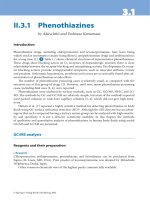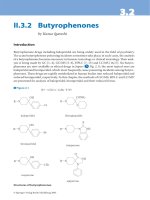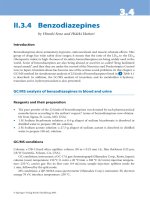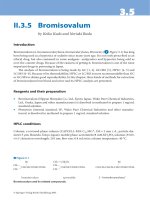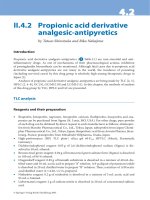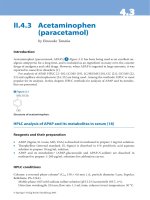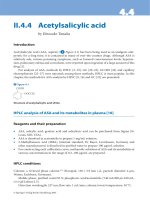Tài liệu Drugs and Poisons in Humans - A Handbook of Practical Analysis (Part 45) pdf
Bạn đang xem bản rút gọn của tài liệu. Xem và tải ngay bản đầy đủ của tài liệu tại đây (608.02 KB, 10 trang )
© Springer-Verlag Berlin Heidelberg 2005
II.5.3 Hair dyes
by Kazuhiro Koyama and Takaaki Kikuno
Introduction
Nowadays, numerous kinds of hair dyes are being commercially available. Hair dyes are classi-
ed into “reactive hair dyes” with high toxicity and into “adhering hair dyes” with lower toxic-
ity. e reactive hair dyes form a polymerized dye by oxidative reactions inside hair, while the
adhering hair dyes only adhere to the outer surface of hair without chemical reaction. In view
of poisoning, the reactive hair dyes are objects of interest and of analysis. A reactive hair dye
consists of main components for polymerization (
> Figure 3.1), a coupler for adjusting the
color development (
> Figure 3.2) and an oxidizer (several % hydrogen peroxide and others).
Usually, the hair dye components and the coupler are contained in the rst bottle, and the
oxidizer and other compound(s) contained in the second bottle. e both uids in the bottles
are mixed just before use [1, 2]. Many chemicals (
> Figures 3.1 and 3.2) are being used for
hair dyes. Among them, p-phenylenediamine shows the highest toxicity, and fatal poisoning
cases due to this compound were reported. For other compounds being used for hair dyes,
their toxicities for humans are not well known.
p-Phenylenediamine is rapidly absorbed into blood through mucous membranes of the
digestive tract a er its oral intake, and metabolized into quinonediimine, which acts as a cyto-
toxin. It is acetylated into N-acetyl-p-phenylenediamine for detoxi cation to be excreted into
urine [2]. As its poisoning symptoms a er oral intake, vomiting, epigastralgia, edemas of the
face, neck and pharynx, dyspnea, acute renal failure, rhabdomyolysis, hemolysis, methemoglo-
binemia, hepatic disorders and others can occur [1, 2]. In 20 fatal p-phenylenediamine poison-
ing cases, convulsion, facial edema and cyanosis were characteristic, and edemas of the epiglot-
tis and vocal folds were observed in all cases [3].
In this chapter, a method for GC/MS analysis of hair dye components is described.
Reagents and their preparation
• o-Phenylenediamine, m-phenylenediamine, p-phenylenediamine, p-aminophenol, catechol,
resorcinol and hydroquinone can be purchased from Sigma (St. Louis, MO, USA); N-phe-
nyl-p-phenylenediamine, o-aminophenol, m-aminophenol, toluene-3,4-diamine (3,4-di-
aminotoluene) and toluene-2,4-diamine (2,4-diaminotoluene), from Aldrich (Milwaukee,
WI, USA). A 10-mg aliquot each of the above compounds
a
is dissolved in 100 mL metha-
nol to prepare 100 µg/mL standard solution in a volumetric ask.
• A 1-mg aliquot of promazine hydrochloride (Sigma) is dissolved in 100 mL distilled water
to prepare its 10 µg/mL solution (internal standard, IS).
5.35.3
416 Hair dyes
Structures and LD
50
values of principal hair dye couplers [1].
⊡ Figure 3.2
Structures and LD
50
values of principal hair dye components for oxidative polymerization [1].
⊡ Figure 3.1
417Hair dyes
GC/MS analysis
GC column: SGE BPX35 (30 m × 0.53 mm i.d.
b
, lm thickness 1.0 µm, Shimadzu GLC Center,
Tokyo, Japan).
GC/MS conditions; instrument: GCMS-QP5050Ancw (Shimadzu Corp., Kyoto, Japan);
column (oven) temperature: 100 °C (1.5 min) → 7 °C/min → 200 °C → 5 °C/min → 330 °C
(7 min); interface temperature: 280 °C; injection device: a PTV
c
splitless high-pressure in-
jection
d
method, 50 °C (0.01 min) → 250 °C/(min) → 330 °C (10 min); initial pressure of in-
jection: 200 kPa, 1.5 min; injection volume: 10 µL; split ratio: 10; sampling time: 1.9 min;
column ow rate: 15 mL/min; ionization: EI; scan range (
> Figure 3.3): m/z 10–509
e
; scan
interval: 0.5 s [4].
Procedures
i. Liquid-liquid extraction
i. e highly toxic components being contained in a product, which is suspected to be in-
gested by a patient, are picked up. If three compounds are involved, a 10-µL each of their
standard solutions (100 µg/mL) is combined (in total 30 µL) and mixed with 470 µL of
blank serum to prepare 500 µL
f
of the spiked standard solution (2 µg each/mL)
g
.
ii. A 500-µL specimen each of serum, gastric juice and/or urine or the above 500-µL spiked
standard solution is mixed with 2 mL ethyl acetate, 500 µL distilled water and 50 µL IS
solution in a test tube with a ground-in stopper.
iii. A er shaking for 3 min, each tube is centrifuged at 3,000 rpm for 5 min; the upper phase
(ethyl acetate phase) is transferred to a glass vial and evaporated to dryness under a stream
of nitrogen at 50 °C.
Total ion chromatogram (TIC) for the standard compounds of principal hair dye components.
1: catechol; 2: o-aminophenol; 3: o-phenylenediamine; 4: hydroquinone; 5: p-aminophenol;
6: p-phenylenediamine plus resorcinol; 7: m-aminophenol; 8: toluene-3,4-diamine; 9: m-phenyl-
enediamine; 10: toluene-2,4-diamine; 11: N-phenyl-p-phenylenediamine.
⊡ Figure 3.3
418 Hair dyes
Mass spectra of principal hair dye components.
⊡ Figure 3.4
419Hair dyes
Mass spectra of principal compounds being used as hair dye couplers.
⊡ Figure 3.5
